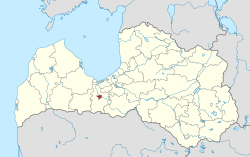
Back Jelgava AF يلغافا Arabic يلجافا ARZ Yelqava AZ Jelgava BAT-SMG Елгава BE Елгава BE-X-OLD Йелгава Bulgarian Jelgava BR Jelgava Catalan
Jelgava | |
|---|---|
State city | |
|
| |
 Jelgava highlighted in Latvia. | |
| Coordinates: 56°38′54″N 23°42′50″E / 56.64833°N 23.71389°E | |
| Country | |
| Town rights | 1573 |
| Government | |
| • Mayor | Andris Rāviņš[1] (LZS) |
| • Number of City Council members | 15 |
| Area | |
• Total | 60.56 km2 (23.38 sq mi) |
| • Land | 57.66 km2 (22.26 sq mi) |
| • Water | 2.9 km2 (1.1 sq mi) |
| Elevation | 13 m (43 ft) |
| Population (2024)[3] | |
• Total | 54,701 |
| • Density | 900/km2 (2,300/sq mi) |
| Demonym | Jelgavnieki (Latvian) |
| GDP | |
| • State city | 740,034,000 Euro (2021) |
| • Per capita | 13,462 Euro (2021) |
| Time zone | UTC+2 (EET) |
| • Summer (DST) | UTC+3 (EEST) |
| Postal code | LV-300(1–9); LV-3024; LV-3035 |
| Calling code | (+371) 630 |
| Website | www |
Jelgava (pronounced [ˈjælˠɡɐvˠɐ] ⓘ) is a state city in central Latvia. It is located about 41 kilometres (25 miles) southwest of Riga. It is the largest town in the Semigallia region of Latvia. Jelgava was the capital of the united Duchy of Courland and Semigallia (1578–1795) and was the administrative center of the Courland Governorate (1795–1918).
Jelgava is situated on a fertile plain rising only 3.5 metres (11.5 feet) above mean sea level on the right bank of the river Lielupe. At high water, the plain and sometimes the town as well can be flooded. It is a railway center, and is also a host to the Jelgava Air Base. Its importance as a railway centre can be seen by the fact that it lies at the junction of over 6 railway lines connecting Riga to Lithuania, eastern and western Latvia, and Lithuania to the Baltic Sea.
- ^ Jelgava City municipality web page Archived 30 September 2011 at the Wayback Machine
- ^ "Reģionu, novadu, pilsētu un pagastu kopējā un sauszemes platība gada sākumā". Central Statistical Bureau of Latvia. Retrieved 7 January 2025.
- ^ "Iedzīvotāju skaits pēc tautības reģionos, pilsētās, novados, pagastos, apkaimēs un blīvi apdzīvotās teritorijās gada sākumā (pēc administratīvi teritoriālās reformas 2021. gadā)". Central Statistical Bureau of Latvia. Retrieved 19 June 2024.
- ^ "Iekšzemes kopprodukts un bruto pievienotā vērtība pa darbības veidiem reģionos un valstspilsētās faktiskajās cenās (pēc administratīvi teritoriālās reformas 2021. gadā)". Central Statistical Bureau of Latvia. Retrieved 22 August 2024.







